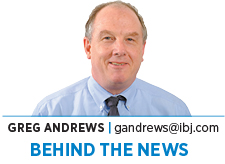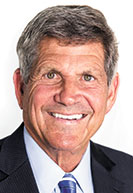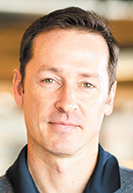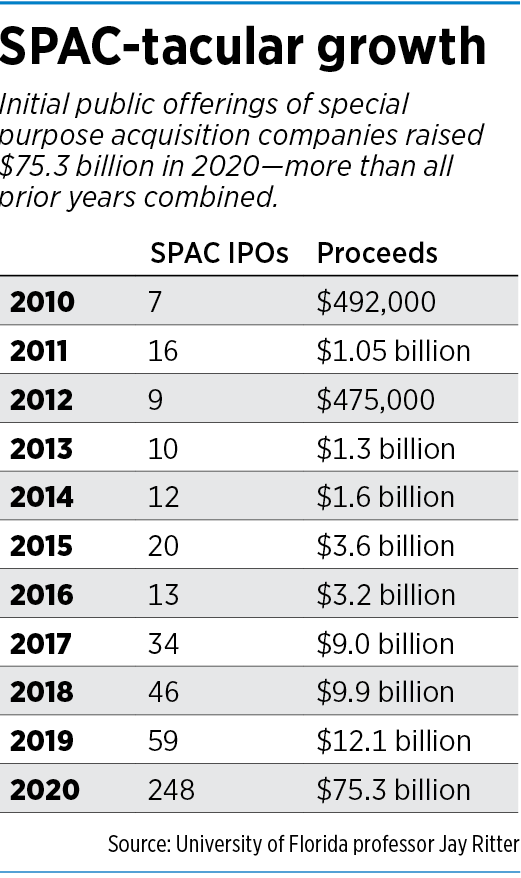Subscriber Benefit
As a subscriber you can listen to articles at work, in the car, or while you work out. Subscribe Now A nontraditional way to take companies public is booming on Wall Street—and making bucketsful of money for some Indianapolis businesspeople engineering the deals.
A nontraditional way to take companies public is booming on Wall Street—and making bucketsful of money for some Indianapolis businesspeople engineering the deals.
That certainly applies to the roughly 20 founders of Indianapolis-based Novus Capital Corp., including Chairman Bob Laikin, who collectively have paper profits of $122 million since creating their business in March.
Novus is what’s known as a SPAC, or special purpose acquisition company. Such firms are merely shell companies with no operations when they go public. They then use IPO proceeds, often along with additional cash raised privately, to buy a business.


Laikin, 57, the founder and former CEO of Brightpoint Inc., now is launching a second SPAC. Emmis Communications Corp. Chairman Jeff Smulyan has created one as well. Meanwhile, the Indianapolis venture capital firm HG Ventures, an affiliate of the Heritage Group, recently helped sell one of its portfolio companies to a SPAC, with spectacular results.
Sales to SPACs effectively give the acquired business a back-door way to go public, one that’s usually speedier and has less uncertainty than the traditional, months-long process for an initial public offering.
Based on the rules governing SPACs, shareholders also have far less risk than in a traditional IPO. Even if shareholders by majority vote approve an acquisition, individual shareholders have the right to walk away and receive their money back, with interest, if they don’t like the purchase.
They also get their money back, with interest, if the SPAC’s sponsor fails to make an acquisition within a set time period, often 24 months.
“The target company is able to go public quickly without much of the volatility with a traditional IPO, and investors get access to high-reward investments with limited risk,” CB Insights said in a research report.
Those dynamics have led to an unprecedented explosion in SPAC IPOs. SPAC sponsors completed 248 last year, raising more than $7 billion—more than SPAC IPOs had raised in all prior years combined.
SPACs, which represented 60% of IPOs in 2020, have blasted out of the gates in 2021, with 53 completed in the first two weeks. And in the first day of trading, the stock price for those firms rose an average of 6.6%, said Jay Ritter, a University of Florida business professor specializing in IPOs.
“What’s happening is, investors have figured out this is a great deal,” Ritter said.
Creating wealth
Rarely do investors fare as well as those who bought shares in Novus, which Laikin formed in March with other tech executives.
The firm raised $100 million in its IPO in May, selling 10 million units at $10 each. Each unit represented one share of common stock and one warrant, which gives holders the right to buy another share in the future at $11.50.
Today, one share fetches about $26 and one warrant fetches about $11. The combined $37, represents a 270% runup. Investors began driving up the price in September after Novus announced it was buying Morehead, Kentucky-based AppHarvest, which aims to revolutionize agriculture by building high-productivity, sustainable, technology-augmented indoor farms.
AppHarvest has an all-star group of backers, including Rupert Murdoch’s son James, legendary investor Jeff Ubben, AOL founder Steve Case, Martha Stewart and best-selling author J.D. Vance.
The firm lost $8.1 million in the first nine months of last year. But it reached a milestone this week when it began shipping its first harvest of beefsteak tomatoes to Kroger, Walmart and other grocers.
Novus is buying AppHarvest for 53 million Novus shares. Those shares were valued at $530 million in September but are now valued at $1.4 billion.
That runup has created mind-spinning wealth for the founders.
As founders, they received 2.7 million shares for about a penny a share. They also capitalized Novus by spending $2.75 million to buy 2.75 million warrants. Each gives them the right to buy a share in the future for $11.50.
In addition, the founders invested $15.25 million to buy 1.525 million shares at $10 apiece in a private, $375 million offering.
In all, the founders are sitting on paper profits of $122 million, more than seven times what they invested.
Laikin, who has paper profits of $15 million, declined to comment on financial terms, citing SEC restrictions while the AppHarvest purchase is pending.
The shareholder vote on the deal is Jan. 29. After it closes, Novus will rename itself AppHarvest Inc.
Laikin now hopes to repeat the magic with Novus Capital Corp. II, which filed Jan. 13 to raise $250 million in an IPO.
Also jumping into the fray is Emmis Communications Corp., which on Tuesday completed the $250 million initial public offering for its SPAC, Monument Circle Acquisition Corp.
“Going public is a very arduous thing” for a business using the traditional IPO route, Smulyan, 73, Emmis’ chairman and CEO, told IBJ. “For companies, this is another way to do it.”
Back-door IPO
The Indianapolis venture capital firm HG Ventures this month helped take one of its portfolio companies, Los Angeles-based Romeo Power, public by selling it to the New York-based SPAC RMG Acquisition Corp. for $900 million.

Five-year-old Romeo plays a key role in the electric-vehicle-battery supply chain, designing battery packs that improve range, acceleration, safety, durability and charging times, said John Glushik, HG’s managing director.
Though the company lost $19 million on revenue of $4.3 million in the first nine months of 2020, investors are jazzed about its potential. Since RMG announced plans for the Romeo purchase in October, shares have doubled in price. The deal closed in December.
Glushik said that, while SPAC IPOs often take less time than traditional ones, the biggest reason for selling to RMG was the opportunity to partner with its leaders and glean their expertise in running and growing public companies.
RMG is led by Chairman James Carpenter, founder and CEO of Connecticut-based merchant banking firm Riverside Management Group, and CEO Robert Mancini, a former managing director of the New York-based private equity firm Carlyle Group and co-head of its power investment business.
“We are big believers in Romeo, the team and the long-term vision of the business, along with the great partnership we now have with RMG,” Glushik said.
RMG raised $230 million in its IPO and another $150 million through the sale of additional shares privately—an infusion that can help Romeo achieve its ambitions.
“One thing that is important about SPACs, and this is the case with Romeo, is it provides an opportunity to very quickly put a lot of capital to work in a capital-intensive business,” Glushik said. “We were able to generate a significant amount of capital to drive growth.”
He wouldn’t say how many millions of dollars HG invested in Romeo, but a Jan. 19 SEC filing shows it now owns 6.2 mil- lion shares worth $116 million. The company has a market value of $2.5 billion.
 Perception shift
Perception shift
SPACs have been around since the 1990s, but for years they had a sketchy reputation, in part because of instances of insider conflicts of interest, high salaries and poor performance.
But perceptions improved as rules governing them became more investor-friendly, said Ritter, the University of Florida professor. For example, the money-back guarantee, in place since 2010, drastically reduced risk, Ritter said.
Since the 2010 change, hedge funds have scarfed up most of the shares in SPAC IPOs, drawn by the fact that they have virtually no short-term risk and substantial upside potential, Ritter said.
He sees a lot to like in SPAC IPOs. Ritter’s research found that the 114 SPAC IPOs that occurred from January 2010 to May 2018 produced an annualized average return of 9.3%.
While the S&P 500 fared better, with a total return of 13.3%, the downside risk for SPACs was minimal. Even the worst-performing SPAC in the study didn’t lose value. It was up 0.5% annually.
He said less than 20% of SPAC acquisitions fail to close, either because too many shareholders asked for their money back or because shareholders rejected the purchase.
When that happens, SPAC sponsors lose the capital they put into the business.
One reason that is so rare is that SPAC offerings are structured in a way that motivates shareholders to green-light purchases, even if they’re going to ask for their money back.
That’s because investors in IPOs, in addition to receiving shares, also get warrants giving them the right to buy more. Those warrants have potential value and can be sold—unless shareholders vote down the deal, in which case they become worthless.
Given those dynamics, Ritter said, “they have an incentive to vote in favor of the merger whether they think it is a good merger or not.”
Smart dealmaking
Long term, the performance of SPAC IPOs will hinge on founders making the right acquisitions.
Laikin acknowledged the challenge.
“Raising money in a SPAC is the easiest thing to do,” he said. “The hardest thing is the day your deal closes. The clock starts and you have to go figure out how to find a deal, how to evaluate your deal, and convince a seller why they should go public through your SPAC rather than the next guy’s SPAC.”
Laikin has extensive deal-making experience. He founded the wireless phone distributor Brightpoint in 1989 and frequently used acquisitions to grow the business before selling it to Ingram Micro Inc. in 2012 for $840 million.
Novus’ CEO, Larry Paulson, 66, also was an executive at Brightpoint, in addition to Qualcomm and Nokia. Novus said in an investor presentation that Laikin and Paulson combined have done 100 deals valued at $5 billion.
Before its IPO, Novus had said it planned to pursue acquisitions in such high-tech fields as 5G, virtual reality or artificial intelligence. But the company scouted for candidates even more broadly, developing a list of more than 100 prospective targets along the way. It evaluated more than 25 potential transactions, from a developer of autonomous mobile robots to an online retailer of contact lenses, according to an SEC filing.
AppHarvest wasn’t on Novus’ radar until August, when the financial adviser for AppHarvest approached Novus about a deal.
“Larry and I knew nothing about farming and agriculture and very little about sustainability,” said Laikin, who enlisted two ag experts to accompany him and Paulson when they went to see AppHarvest’s 60-acre farm firsthand.
He soon became a devout believer, impressed by the vision and business plan of founder and CEO Jonathan Webb and Jeff Ubben, one of the company’s largest shareholders.
Ubben, an Elkhart native, ran ValueAct Capital Management LP, one of the West Coast’s largest hedge funds, before launching the socially conscious investing firm Inclusive Capital Partners last year.
The pair talked about how their business would address global warming, climate change, the need for more food to address population growth and the growing scarcity of water.
Laikin and Paulson also were amazed by the magnitude of the indoor greenhouse—nearly 3.8 million square feet, or the equivalent of 65 football fields.
“We had never seen something of the scale and size of what these folks had built,” Laikin said. “This is one of many indoor farms they were planning to build in the next three to five years. To us, it seemed like a great opportunity for a great business for the long term.”
Chasing a deal
Laikin is shooting for an even bigger acquisition with Novus Capital Corp. II, perhaps one as large as $6 billion.
Smulyan’s Monument Circle is shooting for a deal between $1 billion and $2 billion. Smulyan said the purchase probably would come from media, entertainment, sports or technology—fields in which his management team has 40 years of experience.
In an SEC filing, Monument Circle elaborates, saying “there are several opportunities for media and marketing savvy companies to aggregate audiences around valuable property, such as sports rights, sponsorships or carriage deals.”
Smulyan is a former owner of the Seattle Mariners, and Emmis created the nation’s first all-sports radio station, WFAN, in New York in 1987.
Emmis also has had its challenges, which forced the company in recent years to drastically shrink its holdings and reduce debt, as its core business—radio—lost advertising revenue to newer technologies.
Ritter said investors might have given Smulyan the benefit of the doubt, given radio’s struggles were industry-wide. Investors are so hungry for SPAC IPOs that they are less discerning than they once were, he said.
“The demand for SPAC IPOs has been increasing faster than the supply of IPOs, even though the supply has been exploding,” he said.
Ritter noted that those same dynamics cast uncertainty over the industry.
“There is a bit of a bubble going on,” he said. “With so many SPACs going public, they are all looking for operating companies to buy. That increases the bargaining power of the operating company.
“You can get into a bidding war. That makes it harder for SPACs to do a merger at terms that are attractive for a SPAC.”•
Please enable JavaScript to view this content.

